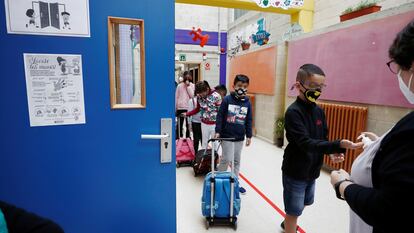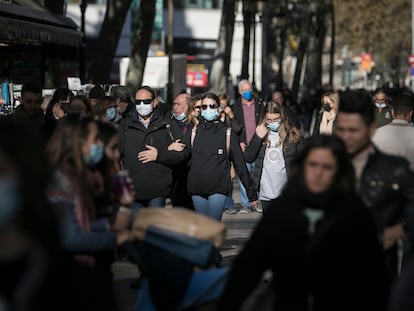School quarantines for Covid rise slightly as Spain battles sixth coronavirus wave
Just 0.38% of classes are in self-isolation, far from the peak recorded last year. But experts are concerned that outbreaks are being detected in education centers

Schools in Spain have not been spared from the latest wave of coronavirus infections, the sixth to hit the country since the beginning of the pandemic. This current spike is taking the biggest toll on the under-12s, which are the only age group in Spain yet to be vaccinated. According to the latest figures, released on Tuesday evening, the 14-day incidence rate among this group is 412 cases per 100,000 – the highest of all age brackets.
Despite this, the percentage of students in quarantine due to the coronavirus remains low. Just 0.28% of classes were in self-isolation between November 21 and 26, a figure that rose to 0.38% last week, according to the latest data provided by Spain’s Education Ministry. Although the 0.38% is just an estimate, as the regions of La Rioja and the Balearic Islands were not able to send in their data due to “technical problems,” it is still far below the peak registered during the previous academic year, when it reached 1.5%. The last school term was in fact considered a success given that educational centers were able to remain open throughout despite the uptick in cases.
Quique Basset, an epidemiologist and member of the Spanish Pediatric Society, warns that the 0.38% data point underestimates the situation in secondary schools, given classes at this education level are not quarantined if a positive case is detected. He does, however, maintain that schools are “safe spaces; there are very few cases and the figures continue to be very good.”
Not all of Spain’s regions have provided the Education Ministry with data on the number of students in quarantine. But according to the figures from those that have, the number has risen more than 38% in the past week, from 37,414 to 51,725. This is the equivalent of 0.89% of all students in these regions.
What is of concern to Bassat is that more outbreaks are being recorded in schools. In other words, education centers have become the source of contagion in some cases. “This did not happen last year. Cases were quickly detected and people stayed in their homes,” he says. “But this year, firstly, more sick children are being sent to school, and the controls at schools have been relaxed.”
The data from the Education Ministry shows that – with the exception of Aragón – each school has an average of more than one class in quarantine. In the Valencia region, the average is 1.7 quarantined classes per school, while in Navarre, the figure is 1.84.
This year, more sick children are being sent to school, and the controls at schools have been relaxedQuique Basset, epidemiologist and member of the Spanish Pediatric Society
Bassat is optimistic that these figures will improve when Spain begins to vaccinate children between the ages of five and 11 on December 15 – a measure that was approved Tuesday by the Public Health Commission, which is made up of central and regional health officials.
According to the Education Ministry data, 95% of quarantined classes are in primary schools and early childhood education centers. This data point, however, does not include figures from La Rioja and the Balearic Islands due to their technical problems, nor from Madrid, Andalusia and Castilla y León, as these regions do not break down figures by school type. Of the regions that did provide data, Aragón, Asturias, Extremadura, Galicia, Murcia, Castilla-La Mancha, and the North African exclave cities of Ceuta and Melilla, reported that 100% of quarantined classes were in primary schools and early childhood education centers.
The situation in Spain’s schools varies between each region. In Spain, the regions are in charge of their Covid-19 restrictions, healthcare systems and vaccination drives. Last week, more than 1% of all classes were quarantined in Navarre (1.59%), Cantabria (1.48%), the Basque Country (1.29%) and Asturias (1.24%). The percentage of affected schools also varies greatly, from 1.7% in Catalonia and 2.42% in Castilla-La Macha, to up to 15.63% and 20.16% in Navarre and the Basque Country, respectively.
The fact that the under-12 age group has the highest incidence rate of the coronavirus and is still not vaccinated has sparked concern among parents. This, combined with the fact that outbreaks “cause a lot of noise,” could contribute to the feeling that the situation in schools is getting out of hand, says Bassat.
“We are all pretty tired, so in the day-to-day, we are probably all forgetting the past a bit,” explains María Carmen Morillas, the vice president of Cepa, the main parents federation of public school students. “Now we have experience in many areas, but when it comes to work-life balance, nothing has changed,” she adds, in reference to her association’s unsuccessful calls for a government mechanism that would allow parents to stay home and look after their children if they have been quarantined. “At the beginning, companies lent a hand a bit more, but not anymore now that all adults have been vaccinated [89.5% of the over-12 are fully vaccinated in Spain].”
José Pedro Caballero, the head of the Concapa federation for parents and family members of students at Catholic schools, says that “the incidence is rising back up quickly, with entire classes in quarantine” – a problem he blames on a drop in support teachers in classrooms this school year. Caballero also expressed anger over the fact that parent associations were not informed or consulted about the plan to vaccinate children before it was approved.
Tu suscripción se está usando en otro dispositivo
¿Quieres añadir otro usuario a tu suscripción?
Si continúas leyendo en este dispositivo, no se podrá leer en el otro.
FlechaTu suscripción se está usando en otro dispositivo y solo puedes acceder a EL PAÍS desde un dispositivo a la vez.
Si quieres compartir tu cuenta, cambia tu suscripción a la modalidad Premium, así podrás añadir otro usuario. Cada uno accederá con su propia cuenta de email, lo que os permitirá personalizar vuestra experiencia en EL PAÍS.
¿Tienes una suscripción de empresa? Accede aquí para contratar más cuentas.
En el caso de no saber quién está usando tu cuenta, te recomendamos cambiar tu contraseña aquí.
Si decides continuar compartiendo tu cuenta, este mensaje se mostrará en tu dispositivo y en el de la otra persona que está usando tu cuenta de forma indefinida, afectando a tu experiencia de lectura. Puedes consultar aquí los términos y condiciones de la suscripción digital.
More information
Últimas noticias
Most viewed
- Reinhard Genzel, Nobel laureate in physics: ‘One-minute videos will never give you the truth’
- Oona Chaplin: ‘I told James Cameron that I was living in a treehouse and starting a permaculture project with a friend’
- Pablo Escobar’s hippos: A serious environmental problem, 40 years on
- Charles Dubouloz, mountaineering star, retires at 36 with a farewell tour inspired by Walter Bonatti
- Why we lost the habit of sleeping in two segments and how that changed our sense of time











































